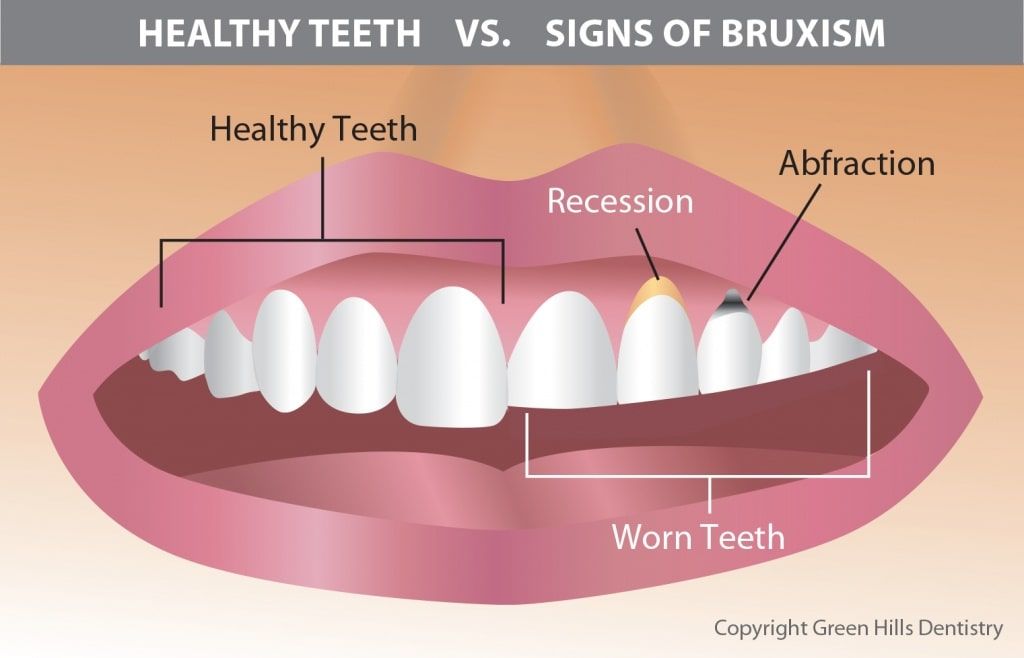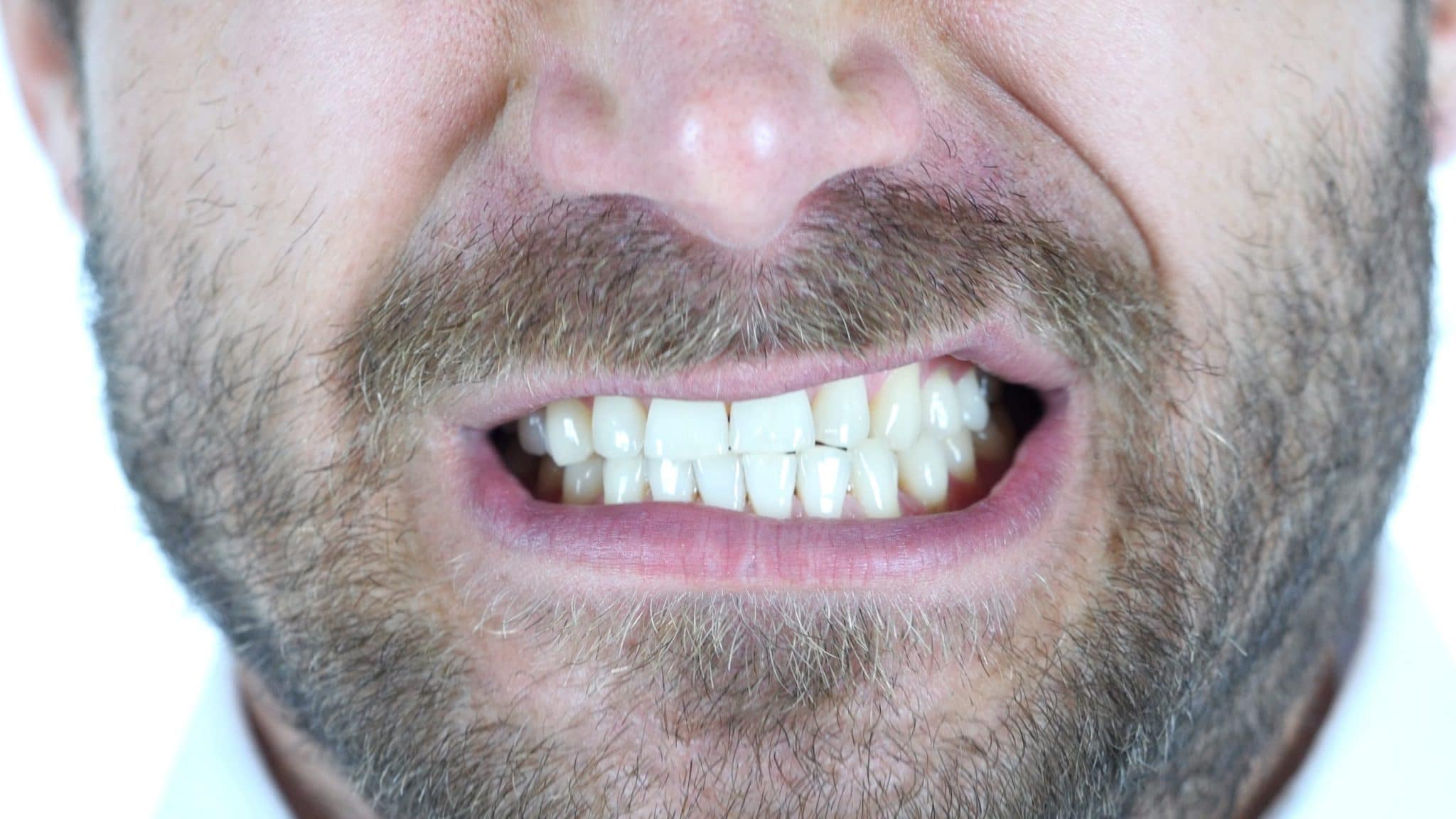You’re googling how to stop grinding teeth. I’m not surprised. Do you know why? Because bruxism is very common. In fact, it’s one of the most common causes of orofacial pain.
It might sound mystifying, but the term bruxism is the medical term for unintentionally grinding or clenching your teeth. Studies show that bruxism affects 20-31% of the population, which I’d argue is an underestimate. Either way, when you consider there are 8 billion people on earth, that amounts to a lot of people inadvertently whittling their teeth away.
And if you don’t think it’s a problem, you have to realize that bruxism is one of the most common reasons why enamel wears down prematurely. Hence, a reason why our smiles prematurely look older. More importantly, it’s a huge factor in why people develop chronic orofacial pain.
But the reason you’re clenching and grinding your teeth in the first place may surprise you. In this article, we’ll talk about bruxism, orofacial pain, how to stop grinding teeth, and why it all matters.
What is Bruxism
Bruxism is a condition, or a parafunctional habit to be specific, in which people chronically grind and clench their teeth. And if your thinking what so wrong with that, teeth are supposed to chew, oh just you wait.
Bruxism is a problem because it’s an uncontrollable movement of the jaw. It analogous to an unconscious twitch of a limb or restless leg syndrome. If you have bruxism, you feel the need to clench and grind your teeth. Even when you attempt not to grind your teeth, you will catch yourself continually doing it.
The condition can occur during the daytime, nighttime, or both. When it happens when you’re awake its called daytime bruxism and when you clench or grind your teeth during sleep it’s called sleep bruxism. Simple enough so far.
Signs and symptoms of bruxism
Some Signs You Might Have Bruxism:
- Teeth grinding or clenching, which is difficult to fully stop
- Teeth that are becoming progressively flattened, chipped or loose
- Tooth pain or sensitivity
- Soreness when trying to eat
- Orofacial pain such as sore jaw muscles or other painful points on the head or neck
- The jaw has a limited opening called lockjaw or gets locked open
- Jaw, neck or face pain or soreness
- Ear fullness or pain that resembles an earache
- Headache which often are on the sides of the head
- Waking up not feeling rested
What Causes Teeth Grinding

The concept of teeth grinding is often misunderstood by many healthcare professionals. The reason is because the cause of bruxism can be related to many factors. Many professionals think teeth grinding is often the result of a combination of physical, psychological, and genetic risk factors. And yes that’s true, but that’s not the whole story.
The most common cause of teeth grinding is related to the harmony between the top jaw and bottom jaw.
Here’s what I mean. The top jaw is fixed in place, only the bottom jaw opens and closes. So what that means is the top jaw is like a stationary fence. The bottom jaw has to open and close within that fence. That’s fine except when the two jaws don’t match quite well. It creates disharmony and that’s the primary cause for bruxism.
For a moment I want you to think of the top teeth and bottom teeth as puzzle pieces. When the top teeth and bottom teeth close together, the teeth fit together, just like a puzzle. But that’s where problems can occur.
It’s not a matter of the teeth fitting together, the jaw also has to also be comfortable closing in that position. When the jaws don’t match quite well, it creates disharmony. The position feels uncomfortable. That’s the primary cause of bruxism.
Because it feels uncomfortable to the muscles, guess what happens? The person feels the need the grind their teeth.
Some Other Risk factors
The teeth and jaw position is one of the most common factors of bruxism but it’s not the only factor at play. Some other risk factors for teeth grinding are:
- Stress. Studies show that anxiety or stress increase the frequency of teeth grinding
- Personality type. People with “type-a” personalities or who are competitive generally are more prone to bruxism.
- Medications or recreational drugs. Some prescription medications, substances, and recreational drugs may increase bruxism. Psychiatric medications, cigarettes, caffeine, and recreational drugs that are stimulants increase the risk of teeth grinding.
- Age. Young children are prone to bruxism during growth years but that doesn’t mean they will be bruxers in adulthood.
- Missing teeth. Numerous extractions of teeth can decrease the stability of the jaw and place additional stress on the remaining teeth which causes the tendency to grind.
- Other Conditions. Bruxism can be a symptoms associated with other medical disorders, such as Parkinson’s disease, dementia, gastroesophageal reflux disorder (GERD), epilepsy, night terrors, sleep-related disorders such as sleep apnea, and attention-deficit/hyperactivity disorder (ADHD).
Why Bruxism Causes Orofacial Pain
Bruxism is a problem for a few reasons. The muscles are working overtime. Instead of the mouth resting at times when a person is not eating, the muscles are constantly moving during the day and night. It would be like going to the gym all day, all night. We’re not designed for that.
The constant jaw movement creates a chronic wearing down of the teeth. Over time the teeth begin to flatten which creates an aged look sooner than ideal.
But all that stress on the teeth has much more dire consequences. It creates orofacial pain. In case you don’t know what that term means, hang on. It will make perfect sense in a couple of paragraphs.
Because the teeth are generally fixed, the stress from bruxism is largely transmitted upward to the head and neck. The muscles, tendons, and nerves of the head and neck begin to receive significantly more load than they ideally should.
When the muscles and structures of the head and neck are under chronic strain for a long period of time, very odd things begin to happen. Bruxism no longer remains a tooth issue; it becomes a condition that affects the entire head and neck.
As the jaw muscles become exhausted, other muscles of the head try to compensate, and soon enough they become exhausted as well. After a period of time, the strain creates a vague sensation of pain in many areas of the head. That is why people with bruxism are prone to not only jaw pain, but also headaches and ear pain.
The oral strain chronically inflames other facial areas. And that’s what creates orofacial pain.
How to Stop Grinding Teeth
The way to stop grinding teeth is to treat the underlying cause. Sounds simple, yes, but you’d be surprised how often dentists miss this. It’s not about protecting the teeth from wear. It’s about allowing the jaw to have a more comfortable home to rest.
If your suffering from daytime bruxism, you most definitely have had this happen to you. You wake up one day and say to yourself, that’s it. I’m making sure I’m not going to grind my teeth today. And in spite of your best efforts, you continually catch yourself during the day doing it.
How frustrating.
For most patients with bruxism issues, it’s bigger than mind over matter. There are usually issues with the harmony of their upper jaw, lower jaw, and TMJ. The issue is usually more than just grinding the teeth. Often people who have bruxism have a collection of other symptoms associated with TMJ disorder.
To treat bruxism and TMJ disorder, it’s all about improving the harmony of the patient’s jaw position. It sounds scary, but it’s quite simple.
The first step usually begins by the patient wearing a custom-designed occlusal splint that helps the patients jaw orient into a better position. The patient wears the occlusal splint for a few months. The occlusal splint is adjusted and the symptoms are evaluated to see how they respond.
Oh and in case your wondering about going to the pharmacy to try an over-the-counter night guard. Not so fast. Those are cleared to prevent wear of the teeth, but they won’t do anything to improve your symptoms of bruxism or TMJ disorder. So if you tried it and didn’t find relief, don’t be too discouraged. Those mouthguards are different. They’re not cleared for TMJ disorder.
After a patient wears a custom occlusal splint for a period of time, and if their symptoms respond well. There is a phase II of treatment in which we start weening the patient off of the occlusal splint by providing them with more permanent treatment. Some treatment that permanently reduces bruxism are orthodontics, botox, occlusal equilibration, and restorative dentistry.
Wrapping Up: Bruxism, Teeth Grinding, and Orofacial Pain
If you are struggling with bruxism or other symptoms of TMJ disorder, it can be frustrating and confusing. When googling how to stop teeth grinding consumes your day, you know you need to do something.
What I want to leave you with is that there are ways to treat these symptoms. Research TMJ specialists in your area. Improving these symptoms can free you from painful distractions in your life. That is hugely liberating.


